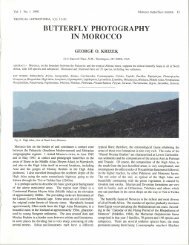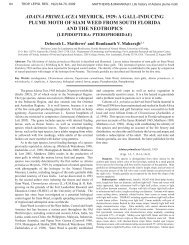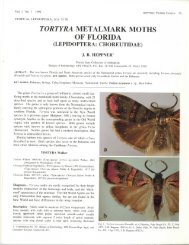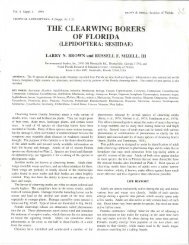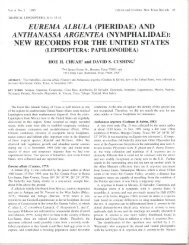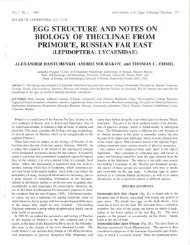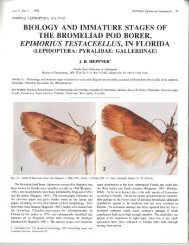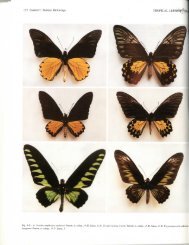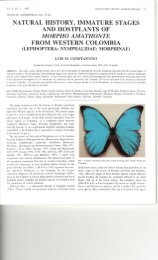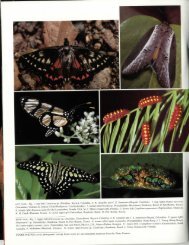ecology and conservation biology of the homerus swallowtail in ...
ecology and conservation biology of the homerus swallowtail in ...
ecology and conservation biology of the homerus swallowtail in ...
Create successful ePaper yourself
Turn your PDF publications into a flip-book with our unique Google optimized e-Paper software.
Vol. l,No. 2 1990 Homerus <strong>swallowtail</strong>: EMMEL <strong>and</strong> GARRAWAY 63<br />
TROPICAL LEPIDOPTERA, 1(2): 63-76<br />
ECOLOGY AND CONSERVATION BIOLOGY<br />
OF THE HOMERUS SWALLOWTAIL<br />
IN JAMAICA<br />
(LEPIDOPTERA: PAPILIONIDAE)<br />
THOMAS C. EMMEL <strong>and</strong> ERIC GARRAWAY<br />
Department <strong>of</strong> Zoology, University <strong>of</strong> Florida, Ga<strong>in</strong>esville, FL 32611 USA, <strong>and</strong><br />
Department <strong>of</strong> Zoology, University <strong>of</strong> <strong>the</strong> West Indies, Mona, K<strong>in</strong>gston 7, Jamaica<br />
ABSTRACT.— The Homerus Swallowtail, Papilio <strong>homerus</strong> Fabricius (Lepidoptera: Papilionidae), once <strong>in</strong>habited seven <strong>of</strong> <strong>the</strong> thirteen parishes on<br />
<strong>the</strong> isl<strong>and</strong> <strong>of</strong> Jamaica. Today, it is found only <strong>in</strong> two isolated <strong>and</strong> dim<strong>in</strong>ish<strong>in</strong>g strongholds: an eastern population <strong>in</strong> <strong>the</strong> parishes <strong>of</strong> St. Thomas <strong>and</strong><br />
Portl<strong>and</strong>, <strong>and</strong> <strong>the</strong> western population <strong>in</strong> <strong>the</strong> rugged Cockpit Country <strong>of</strong> Trelawny <strong>and</strong> St. Elizabeth. The <strong>ecology</strong> <strong>of</strong> <strong>the</strong> rema<strong>in</strong><strong>in</strong>g populations is<br />
described, <strong>in</strong>clud<strong>in</strong>g habitat characteristics, seasonally, altitud<strong>in</strong>al range, host plants, behavior <strong>and</strong> o<strong>the</strong>r associated biological <strong>in</strong>formation. A<br />
summary <strong>of</strong> <strong>the</strong> stages <strong>of</strong> life history is illustrated by color photographs. The pr<strong>in</strong>cipal threats to <strong>the</strong> cont<strong>in</strong>ued existence <strong>of</strong> <strong>the</strong> species are (1)<br />
destruction <strong>of</strong> <strong>the</strong> virg<strong>in</strong> wet ra<strong>in</strong> forest habitat, <strong>and</strong> (2) commercial collect<strong>in</strong>g <strong>in</strong> <strong>the</strong> rema<strong>in</strong><strong>in</strong>g small populations. The establishment <strong>of</strong> patrolled<br />
nature reserves or a national park is recommended for <strong>the</strong> rema<strong>in</strong><strong>in</strong>g habitat areas, as well as a possible butterfly farm<strong>in</strong>g program to lessen pressures<br />
on small wild populations.<br />
KKY WORDS: Agehana, butterfly fann<strong>in</strong>g, Hern<strong>and</strong>iaceae, immature stages, Lauraceae, life history, Ornithoptera, Papilio <strong>homerus</strong>, population <strong>ecology</strong>,<br />
West Indies.<br />
Fig. 1. Papilio <strong>homerus</strong> Fabricius, adult female reared from larva collected near Millbank, Jamaica, <strong>in</strong> August 1986 (emerged 13 Sep 1986 <strong>in</strong> Ga<strong>in</strong>esville, FL): a)<br />
dorsal view; b) ventral view.<br />
The Homerus Swallowtail, Papilio <strong>homerus</strong> Fabricius, is one<br />
<strong>of</strong> <strong>the</strong> most spectacular butterflies <strong>in</strong> <strong>the</strong> world, <strong>and</strong> is <strong>the</strong> largest<br />
<strong>swallowtail</strong> <strong>in</strong> <strong>the</strong> Americas. With its bold black-<strong>and</strong>-yellow<br />
pattern <strong>and</strong> huge spatulate tails, no o<strong>the</strong>r species can be confused<br />
with this gigantic <strong>and</strong> magnificent <strong>swallowtail</strong>. It is conf<strong>in</strong>ed to<br />
<strong>the</strong> Caribbean isl<strong>and</strong> <strong>of</strong> Jamaica, where it once <strong>in</strong>habited seven <strong>of</strong><br />
<strong>the</strong> thirteen parishes. Today, it is found only <strong>in</strong> two isolated <strong>and</strong><br />
dim<strong>in</strong>ish<strong>in</strong>g strongholds: an eastern population <strong>in</strong> <strong>the</strong> parishes <strong>of</strong><br />
St. Thomas <strong>and</strong> Portl<strong>and</strong> at <strong>the</strong> junction <strong>of</strong> <strong>the</strong> Blue Mounta<strong>in</strong>s<br />
<strong>and</strong> <strong>the</strong> John Crow Range, <strong>and</strong> a western population <strong>in</strong> <strong>the</strong> rugged<br />
Cockpit Country <strong>of</strong> Trelawny Parish. Of <strong>the</strong> 573 recognized<br />
species <strong>of</strong> Papilionidae, it is listed as one <strong>of</strong> <strong>the</strong> four endangered
64 EMMEL <strong>and</strong> GARRAWAY: Homerus <strong>swallowtail</strong> TROPICAL LEPIDOPTERA<br />
Turks & Caicos /st<strong>and</strong>s<br />
(Br.)<br />
Cayman Isl<strong>and</strong>s<br />
(Br) HAITI/ DOMINICAN<br />
JAMAICA<br />
Port-au-<br />
Pr<strong>in</strong>ce B<br />
, REPUBLIC<br />
K<strong>in</strong>gston<br />
'Santo<br />
Dom<strong>in</strong>go<br />
Fig. 2. Despite <strong>the</strong> central location <strong>of</strong> Jamaica <strong>in</strong> <strong>the</strong> Caribbean (a), no similar ra<strong>in</strong> forest habitat with 300 <strong>in</strong>ches <strong>of</strong> precipitation occurs on <strong>the</strong> o<strong>the</strong>r nearby major<br />
isl<strong>and</strong>s, <strong>and</strong> <strong>the</strong> Homerus Swallowtail is thus endemic only to Jamaica, (b) The Homerus Swallowtail, Papilio <strong>homerus</strong>, is <strong>the</strong> largest <strong>swallowtail</strong> <strong>in</strong> <strong>the</strong> Americas <strong>and</strong><br />
one <strong>of</strong> <strong>the</strong> largest butterfly species <strong>in</strong> <strong>the</strong> world. Its bold yellow <strong>and</strong> black pattern with huge spatulate tails <strong>and</strong> iridescent blue scal<strong>in</strong>g on <strong>the</strong> h<strong>in</strong>d w<strong>in</strong>gs is clearly<br />
visible from hundreds <strong>of</strong> feet away, <strong>and</strong> <strong>the</strong> slow majestic flight thrills <strong>the</strong> observer, (c) The Com Puss Gap pass <strong>in</strong> <strong>the</strong> John Crow Mts. south <strong>of</strong> Millbank, where <strong>the</strong><br />
ra<strong>in</strong> forest <strong>and</strong> <strong>the</strong> Homerus Swallowtail are threatened by <strong>the</strong> same clear<strong>in</strong>g operations tak<strong>in</strong>g place closer to Millbank. (d) Dr. Eric Gairaway <strong>of</strong> <strong>the</strong> University <strong>of</strong><br />
<strong>the</strong> West Indies at <strong>the</strong> Isl<strong>and</strong> Spr<strong>in</strong>g site near Millbank. (e) Forest vegetation at <strong>the</strong> edge <strong>of</strong> <strong>the</strong> Isl<strong>and</strong> Spr<strong>in</strong>g study site, where P. <strong>homerus</strong> <strong>of</strong>ten come down to bask<br />
<strong>in</strong> <strong>the</strong> sun on leaves near <strong>the</strong> water's edge. (Photos © Thomas C. Emmel)
Vol. lf No. 2 1990 Homcrus <strong>swallowtail</strong>: EMMEL <strong>and</strong> GARRAWAY 65<br />
<strong>swallowtail</strong> species <strong>in</strong> <strong>the</strong> 1UCN Red Data Book, "Threatened<br />
Swallowtail Butterflies <strong>of</strong> <strong>the</strong> World" (Morris <strong>and</strong> Coll<strong>in</strong>s, 1985).<br />
With <strong>the</strong> present rapid rate <strong>of</strong> destruction <strong>of</strong> its habitat <strong>in</strong><br />
Jamaica, <strong>the</strong> species has attracted recent attention as a c<strong>and</strong>idate<br />
for preservation, perhaps through <strong>the</strong> formation <strong>of</strong> one or more<br />
national parks <strong>and</strong> nature reserves <strong>in</strong> <strong>the</strong> mounta<strong>in</strong>s <strong>of</strong> Jamaica,<br />
<strong>and</strong> also as a c<strong>and</strong>idate for imm<strong>in</strong>ent disappearance, rais<strong>in</strong>g <strong>the</strong><br />
value <strong>of</strong> perfect adults to collectors <strong>and</strong> commercial dealers who<br />
are cont<strong>in</strong>u<strong>in</strong>g to take specimens even after <strong>the</strong> 1988 Jamaican<br />
government ban <strong>and</strong> CITES treaty ban on collect<strong>in</strong>g <strong>and</strong> export<strong>in</strong>g<br />
<strong>the</strong>m. The present paper summarizes our knowledge <strong>of</strong> <strong>the</strong><br />
<strong>biology</strong> <strong>and</strong> <strong>ecology</strong> <strong>of</strong> this spectacular <strong>swallowtail</strong> from <strong>the</strong><br />
literature <strong>and</strong> from <strong>in</strong>tensive <strong>in</strong>dividual <strong>and</strong> collaborative research<br />
projects <strong>in</strong> Jamaica.<br />
DESCRIPTION OF POPULATION AREAS<br />
PHYSIOGRAPHY AND BIOGEOGRAPHY<br />
A better underst<strong>and</strong><strong>in</strong>g <strong>of</strong> <strong>the</strong> distribution <strong>and</strong> factors controll<strong>in</strong>g<br />
<strong>the</strong> range for Papilio <strong>homerus</strong> may be obta<strong>in</strong>ed by a brief<br />
look at <strong>the</strong> physiography <strong>of</strong> <strong>the</strong> isl<strong>and</strong>. The follow<strong>in</strong>g descriptions<br />
follow those <strong>of</strong> Cruz (1977), with additional <strong>in</strong>formation<br />
from o<strong>the</strong>r sources.<br />
Jamaica lies at 18° N latitude <strong>in</strong> <strong>the</strong> western Caribbean,<br />
approximately 150km south <strong>of</strong> <strong>the</strong> nearest po<strong>in</strong>t on Cuba <strong>and</strong><br />
some 200km west <strong>of</strong> Hispaniola, <strong>the</strong> only two isl<strong>and</strong>s <strong>in</strong> <strong>the</strong> West<br />
Indies to exceed Jamaica <strong>in</strong> size. The nearest ma<strong>in</strong>l<strong>and</strong> area is<br />
Honduras <strong>in</strong> Central America, approximately 610km to <strong>the</strong><br />
southwest. Jamaica has a l<strong>and</strong> area <strong>of</strong> 11,740 square km <strong>and</strong><br />
much <strong>of</strong> <strong>the</strong> terra<strong>in</strong> is quite mounta<strong>in</strong>ous, with more than half <strong>of</strong><br />
<strong>the</strong> isl<strong>and</strong> exceed<strong>in</strong>g 305m (1,000ft) <strong>in</strong> elevation. The Central<br />
Upl<strong>and</strong> plateau at 600 - 915m, <strong>and</strong> <strong>the</strong> Blue <strong>and</strong> John Crow<br />
mounta<strong>in</strong> ranges to <strong>the</strong> east, comprise most <strong>of</strong> <strong>the</strong> higher<br />
mounta<strong>in</strong>s.<br />
The Blue Mounta<strong>in</strong>s run approximately one-third <strong>the</strong> length <strong>of</strong><br />
<strong>the</strong> isl<strong>and</strong>, extend<strong>in</strong>g westward from <strong>the</strong> John Crow Range at <strong>the</strong><br />
eastern edge <strong>of</strong> <strong>the</strong> isl<strong>and</strong> to Ml. Telegraph (1,275m). Their<br />
maximum height reaches 2,155m. The Central Upl<strong>and</strong> plateau<br />
conta<strong>in</strong>s <strong>the</strong> Dry Harbor Mounta<strong>in</strong>s (<strong>in</strong> St. Ann Parish) <strong>and</strong> <strong>the</strong><br />
Mocho Mounta<strong>in</strong>s (Clarendon Parish), separated by <strong>the</strong> Ma<strong>in</strong><br />
Ridge group. In <strong>the</strong> western third <strong>of</strong> <strong>the</strong> isl<strong>and</strong> is <strong>the</strong> Cockpit<br />
Country, where s<strong>in</strong>kholes from 200 - 600ft deep form <strong>the</strong><br />
characteristic topography <strong>of</strong> west-central Jamaica. A succession<br />
<strong>of</strong> cone-like hills with deep pits at <strong>the</strong> base <strong>of</strong> each "cockpit" (so<br />
named because <strong>the</strong>y resemble cock-fight<strong>in</strong>g pits or arenas)<br />
represent typical karst country, with underground dra<strong>in</strong>age, many<br />
subterranean rivers, s<strong>in</strong>kholes <strong>and</strong> caves. In <strong>the</strong> Cockpit<br />
Country's 400 square miles, <strong>the</strong>re are no flat surfaces nor any<br />
easily navigable paths.<br />
Mount Diablo (1,000m elev.), located <strong>in</strong> St. Ca<strong>the</strong>r<strong>in</strong>e Parish <strong>in</strong><br />
<strong>the</strong> central portion <strong>of</strong> <strong>the</strong> isl<strong>and</strong>, is a very precipitous, calcareous<br />
plateau, similar <strong>in</strong> terra<strong>in</strong> to <strong>the</strong> Cockpit Country.<br />
CLIMATE<br />
Ra<strong>in</strong>fall varies greatly throughout <strong>the</strong> isl<strong>and</strong>, depend<strong>in</strong>g on <strong>the</strong><br />
local physiography. Moisture-laden easterly tradew<strong>in</strong>ds blow<br />
throughout <strong>the</strong> year. These are uplifted <strong>and</strong> cooled, with resultant<br />
precipitation, as <strong>the</strong>y cross <strong>the</strong> John Crow Mounta<strong>in</strong>s <strong>and</strong> <strong>the</strong>n <strong>the</strong><br />
nor<strong>the</strong>rn flank <strong>of</strong> <strong>the</strong> Blue Mounta<strong>in</strong>s. Hence <strong>the</strong> parishes <strong>in</strong> <strong>the</strong><br />
nor<strong>the</strong>ast <strong>of</strong> Jamaica, particularly Portl<strong>and</strong>, receive heavy ra<strong>in</strong>fall<br />
with an average annual ra<strong>in</strong>fall <strong>of</strong> 381cm, <strong>and</strong> actually reach<br />
650cm (300 <strong>in</strong>ches) at <strong>the</strong> junction <strong>of</strong> <strong>the</strong> Blue Mounta<strong>in</strong>s <strong>and</strong> <strong>the</strong><br />
John Crow Mounta<strong>in</strong>s. (In contrast, <strong>the</strong> dry sou<strong>the</strong>rn parish <strong>of</strong> St.<br />
Andrew receives only 89cm <strong>of</strong> ra<strong>in</strong>.) In <strong>the</strong> Cockpit Country, <strong>the</strong><br />
area gets 150-200 <strong>in</strong>ches <strong>of</strong> precipitation a year.<br />
Ra<strong>in</strong>fall here is quite seasonal, with <strong>the</strong> wet season <strong>and</strong><br />
heaviest ra<strong>in</strong>s occurr<strong>in</strong>g <strong>in</strong> May <strong>and</strong> June <strong>and</strong> aga<strong>in</strong> from August<br />
to November. The major dry season is from January to March.<br />
Papilio <strong>homerus</strong> seems to require quite wet sites with heavy<br />
ra<strong>in</strong>fall, <strong>and</strong> Garraway has photographed <strong>the</strong> larvae actually<br />
dr<strong>in</strong>k<strong>in</strong>g ra<strong>in</strong> droplets from <strong>the</strong> surface <strong>of</strong> a leaf. Both <strong>of</strong> us have<br />
observed that <strong>the</strong> larvae cannot survive <strong>in</strong> areas <strong>of</strong> less than close<br />
to 100% humidity.<br />
VEGETATION AND PLANT COMMUNITIES<br />
Of <strong>the</strong> eight major vegetation communities described by<br />
Asprey <strong>and</strong> Robb<strong>in</strong>s (1953), Papiio <strong>homerus</strong> habitats <strong>in</strong>clude Wet<br />
Limestone Forest <strong>and</strong> Lower Montane Ra<strong>in</strong> Forest. Wet<br />
Limestone Forest develops on limestone rock where <strong>the</strong> ra<strong>in</strong>fall<br />
is over 190cm <strong>and</strong> may be as high as 380 cm. This forest occurs<br />
largely <strong>in</strong>l<strong>and</strong> at elevations from 300-780m. Many tree species<br />
are present, toge<strong>the</strong>r with epiphytes, lianas, aroids, <strong>and</strong> bromeliads.<br />
The canopy is about 20m <strong>in</strong> height, quite dense, <strong>and</strong> has<br />
emergent trees tower<strong>in</strong>g up to 30m or more. For P. <strong>homerus</strong><br />
habitats, this forest type is present particularly <strong>in</strong> <strong>the</strong> Mount<br />
Diablo area <strong>in</strong> St. Ca<strong>the</strong>r<strong>in</strong>e Parish <strong>and</strong> <strong>in</strong> <strong>the</strong> Cockpit Country.<br />
Some <strong>of</strong> <strong>the</strong> characteristic trees <strong>in</strong>clude broad-leaf (Term<strong>in</strong>alia<br />
latifolia [Combretaceae]), Jamaican cedar (Cedrela odorata<br />
[Meliaceae]), prickly yellow (Fagara mart<strong>in</strong>icensis [Rutaceae]),<br />
<strong>and</strong> figs (Ficus spp. [Moraceae]). In recently cleared areas where<br />
secondary succession is occurr<strong>in</strong>g, one may f<strong>in</strong>d trumpet trees<br />
(Cecropia peltata [Urticaceae]), citrus trees (Citrus spp. [Rutaceae]),<br />
<strong>and</strong> pimento (Pimento, <strong>of</strong>fic<strong>in</strong>alis [Myrtaceae]). Some <strong>of</strong><br />
<strong>the</strong> species from <strong>the</strong> preced<strong>in</strong>g plant community extend up <strong>in</strong>to<br />
<strong>the</strong> next zone, but <strong>the</strong> Lower Montane Ra<strong>in</strong> Forest basically<br />
occurs at higher elevations, up to 1,070m. Annual ra<strong>in</strong>fall here<br />
normally exceeds 250cm <strong>and</strong> may reach nearly 700cm. Although,<br />
as will be po<strong>in</strong>ted out later, much <strong>of</strong> this community has<br />
been destroyed by human disturbance, this Lower Montane Ra<strong>in</strong><br />
Forest is still present <strong>in</strong> <strong>the</strong> Blue <strong>and</strong> John Crow mounta<strong>in</strong>s.<br />
Particularly nice forest occurs <strong>in</strong> Corn Puss Gap, located <strong>in</strong> St.<br />
Thomas Parish, which lies at an elevation <strong>of</strong> 610 - 686m on <strong>the</strong><br />
southwestern slopes <strong>of</strong> <strong>the</strong> John Crow Mounta<strong>in</strong>s. This forest<br />
consists <strong>of</strong> many <strong>of</strong> <strong>the</strong> tree species found <strong>in</strong> <strong>the</strong> Wet Limestone<br />
Forest <strong>and</strong> has a similar general appearance. Characteristic trees<br />
<strong>of</strong> this plant community also <strong>in</strong>clude mounta<strong>in</strong> guava (Psidium<br />
montanum [Myrtaceae]), Santa Maria (Calophyllum jacqu<strong>in</strong>ii<br />
[Guttiferae]), cobywood (Matayba apetala [Sap<strong>in</strong>daceae]),<br />
rodwood (Eugenia sp. [Myrtaceae]), <strong>and</strong> many o<strong>the</strong>rs, <strong>in</strong>clud<strong>in</strong>g<br />
tree ferns (Cya<strong>the</strong>a spp. [Cya<strong>the</strong>aceae]).<br />
Above <strong>the</strong> Lower Montane Ra<strong>in</strong> Forest is <strong>the</strong> Montane Mist<br />
Forest, which covers <strong>the</strong> upper reaches <strong>of</strong> <strong>the</strong> Blue Mounta<strong>in</strong>s <strong>in</strong><br />
<strong>the</strong> isl<strong>and</strong>'s eastern end. This region <strong>of</strong> high atmospheric<br />
humidity has a high annual ra<strong>in</strong>fall <strong>of</strong> over 200cm, <strong>and</strong> mist
66 EMMEL <strong>and</strong> GARRAWAY: Homerus <strong>swallowtail</strong> TROPICAL LEPIDOPTERA<br />
Fig. 3. A brief overview <strong>of</strong> <strong>the</strong> life history stages <strong>of</strong> Papilio <strong>homerus</strong>: a) egg on a Hern<strong>and</strong>ia sp. leaf near Millbank; b) second-<strong>in</strong>star larva, which resembles a bird<br />
dropp<strong>in</strong>g (<strong>the</strong> feed<strong>in</strong>g damage is readily visible <strong>and</strong> makes it easy to f<strong>in</strong>d <strong>the</strong> larvae look<strong>in</strong>g up through ihe trees); c) <strong>the</strong> mature larva, show<strong>in</strong>g <strong>the</strong> lateral pattern <strong>of</strong><br />
mark<strong>in</strong>gs; d) <strong>the</strong> pupa, brown phase (two color phases arc known, brown <strong>and</strong> green, <strong>in</strong> <strong>the</strong> eastern population); e) <strong>the</strong> adult butterfly, freshly emerged. (TCE)
Vol. 1, No. 2 1990 Homerus <strong>swallowtail</strong>: EMMEL <strong>and</strong> GARRAWAY 67<br />
Fig. 4. Life history stages <strong>of</strong> Papilio <strong>homerus</strong>: a) a mature larva on a Hern<strong>and</strong>ia catalpaefolia leaf, show<strong>in</strong>g <strong>the</strong> huge size <strong>of</strong> <strong>the</strong> larva compared to a man's h<strong>and</strong><br />
<strong>and</strong> f<strong>in</strong>gers; b) a young seedl<strong>in</strong>g <strong>of</strong> Hern<strong>and</strong>ia catalpaefolia <strong>in</strong> <strong>the</strong> forest near Millbank; c) an adult show<strong>in</strong>g <strong>the</strong> underside pattern <strong>and</strong> <strong>the</strong> natural twist<strong>in</strong>g <strong>of</strong> <strong>the</strong><br />
spatulate tails; d) frontal view <strong>of</strong> a mature Homerus larva, show<strong>in</strong>g <strong>the</strong> snake-like mark<strong>in</strong>gs on <strong>the</strong> thorax; e) a young seedl<strong>in</strong>g <strong>of</strong> Hern<strong>and</strong>ia troyiana <strong>in</strong> <strong>the</strong> forest near<br />
Eldcrslie, <strong>in</strong> <strong>the</strong> Cockpit Country (this endemic plant serves as <strong>the</strong> foodplant <strong>of</strong> <strong>the</strong> western Homerus population, <strong>and</strong> has smaller leaves with less-regular marg<strong>in</strong>s.<br />
Because <strong>the</strong> larval stages last 45 days <strong>and</strong> move very little, <strong>the</strong>y can easily be observed on a predictable daily basis <strong>and</strong> would be <strong>in</strong>terest<strong>in</strong>g to visitors <strong>in</strong> <strong>the</strong> proposed<br />
national park, <strong>in</strong> addition to see<strong>in</strong>g <strong>the</strong> wild adults. (TCE)
68 EMMEL <strong>and</strong> GARRAWAY: Homerus <strong>swallowtail</strong> TROPICAL LEPIDOPTERA<br />
covers <strong>the</strong> ridges <strong>and</strong> forest almost cont<strong>in</strong>uously. The forest also<br />
has a low canopy, seldom exceed<strong>in</strong>g 12m. While Papilio<br />
<strong>homerus</strong> does not normally reach <strong>the</strong>se elevations <strong>of</strong> 1,100m or<br />
more, <strong>the</strong> structural <strong>in</strong>tegrity <strong>of</strong> <strong>the</strong> higher habitats is important<br />
to supply <strong>the</strong> water flow <strong>and</strong> atmospheric moisture for <strong>the</strong><br />
successful survival <strong>of</strong> <strong>homerus</strong> at lower montane elevations.<br />
The Hern<strong>and</strong>ia (Hcm<strong>and</strong>iaceae) trees that serve as larval host<br />
plants for <strong>homerus</strong> occur primarily <strong>in</strong> <strong>the</strong> first zone mentioned<br />
above, namely <strong>the</strong> Wet Limestone Forest. The larval stage,<br />
which lasts about 45 days <strong>and</strong> has five <strong>in</strong>stars, requires very high<br />
humidity such as is experienced along montane stream canyons<br />
descend<strong>in</strong>g through <strong>the</strong> ra<strong>in</strong> forest. Captive-rear<strong>in</strong>g attempts <strong>in</strong><br />
both Jamaica <strong>and</strong> Florida have shown that Papilio <strong>homerus</strong> is<br />
extremely sensitive to environmental change <strong>in</strong> <strong>the</strong> larval stages,<br />
<strong>and</strong> <strong>the</strong> present clear<strong>in</strong>g <strong>of</strong> <strong>the</strong> forest <strong>in</strong> its rema<strong>in</strong><strong>in</strong>g habitat<br />
areas, with concommitant decrease <strong>in</strong> local humidity levels, bodes<br />
ill for <strong>the</strong> species' long-term survival even if a screen <strong>of</strong> riparian<br />
vegetation was left after clear-cutt<strong>in</strong>g <strong>the</strong> surround<strong>in</strong>g slopes.<br />
DESCRIPTION OF THE ADULT<br />
Papilio <strong>homerus</strong> is <strong>the</strong> largest species <strong>in</strong> <strong>the</strong> true <strong>swallowtail</strong><br />
genus Papilio, <strong>and</strong> it rivals <strong>in</strong> size some <strong>of</strong> <strong>the</strong> birdw<strong>in</strong>gs<br />
(Troid<strong>in</strong>i) <strong>of</strong> Sou<strong>the</strong>ast Asia as well as Papilio antimachus <strong>of</strong><br />
West Africa. It has a forew<strong>in</strong>g length <strong>of</strong> about 75mm, or a<br />
w<strong>in</strong>gspread (<strong>in</strong> some females) that approaches 6 <strong>in</strong>ches (15cm).<br />
Its nearest relatives are <strong>in</strong> Central America <strong>and</strong> Mexico: P.<br />
garamus Hubner <strong>and</strong> P. abderus Hopffer, nei<strong>the</strong>r <strong>of</strong> which<br />
approaches P. <strong>homerus</strong> <strong>in</strong> total size or dramatic beauty. Papilio<br />
garamus is found from Mexico <strong>and</strong> Panama. In Costa Rica, P.<br />
garamus occurs on east <strong>and</strong> west slopes <strong>of</strong> <strong>the</strong> higher mounta<strong>in</strong><br />
ranges <strong>in</strong> cloud forest habitats from l,200-2,800m elevation,<br />
somewhat higher than P. <strong>homerus</strong> <strong>in</strong> Jamaica (DeVries, 1987).<br />
P. garamus flies <strong>in</strong> <strong>the</strong> central eastern <strong>and</strong> western mounta<strong>in</strong>s <strong>of</strong><br />
Mexico from February to November; its larval host is Persea<br />
americana (Lauraceae) (Beutelspachcr <strong>and</strong> Howe, 1984). Papilio<br />
abderus occurs <strong>in</strong> <strong>the</strong> mounta<strong>in</strong>s <strong>of</strong> eastern Mexico, Guatemala<br />
<strong>and</strong> Honduras from March to October; <strong>the</strong> larvae feed on<br />
Lauraceae (Beutelspacher <strong>and</strong> Howe, 1984).<br />
The sexes <strong>of</strong> P. <strong>homerus</strong> are similar <strong>in</strong> coloration <strong>and</strong> pattern,<br />
though <strong>the</strong> females average notably larger <strong>in</strong> size. The ground<br />
color <strong>of</strong> <strong>the</strong> dorsal surface <strong>of</strong> both <strong>the</strong> forew<strong>in</strong>g <strong>and</strong> h<strong>in</strong>dw<strong>in</strong>g is<br />
a blackish or very dark brown. A broad yellow discal b<strong>and</strong><br />
extends across both w<strong>in</strong>gs. On <strong>the</strong> h<strong>in</strong>dw<strong>in</strong>g, <strong>the</strong>re are powdery<br />
blue, postdiscal spots <strong>and</strong> brick-red submarg<strong>in</strong>al lunules. The<br />
relatively long <strong>and</strong> widened spatulate tail is quite dist<strong>in</strong>ctive<br />
among American <strong>swallowtail</strong>s, to be found elsewhere (<strong>and</strong><br />
exceeded perhaps) only <strong>in</strong> Asian species such as Agehana maraho<br />
Shiraki & Sonan <strong>of</strong> Taiwan. The undersides <strong>of</strong> <strong>the</strong> forew<strong>in</strong>g <strong>and</strong><br />
h<strong>in</strong>dw<strong>in</strong>g are similar to <strong>the</strong> upper surfaces <strong>in</strong> <strong>the</strong>ir dark brown<br />
ground color. However, <strong>the</strong> yellow-brown discal b<strong>and</strong> is much<br />
more narrow on <strong>the</strong> h<strong>in</strong>dw<strong>in</strong>g ventrally, <strong>and</strong> it is dusted with blue<br />
scales. Dark mark<strong>in</strong>gs occur between <strong>the</strong> diffuse red <strong>and</strong> blue<br />
spots (see color figures).<br />
EARLY STAGES OF THE LIFE HISTORY<br />
Papilio <strong>homerus</strong> was described by Fabricius <strong>in</strong> 1793, <strong>and</strong> <strong>the</strong><br />
species has been avidly pursued on Jamaica ever s<strong>in</strong>ce. As a<br />
result, <strong>the</strong>re is a considerable bibliography for <strong>the</strong> species. The<br />
first person to describe its habits was Ru<strong>the</strong>rford (1878), <strong>and</strong> <strong>the</strong><br />
follow<strong>in</strong>g year Grosse (1879) announced <strong>the</strong> discovery <strong>of</strong> its egg<br />
<strong>and</strong> larva. Hampton (1893) described <strong>the</strong> mature larva, while<br />
Taylor (1894) described <strong>the</strong> mature larva <strong>and</strong> <strong>the</strong> pupa. Swa<strong>in</strong>son<br />
(1901, p. 77) provided a brief description <strong>of</strong> <strong>the</strong> larva as well.<br />
Brown <strong>and</strong> He<strong>in</strong>eman (1972) summarized <strong>the</strong> published observations<br />
to that year, <strong>and</strong> Coll<strong>in</strong>s <strong>and</strong> Morris (1985) summarized <strong>the</strong><br />
life history <strong>in</strong> brief form, based on unpublished data supplied by<br />
Thomas J. Turner. Turner (<strong>in</strong> press) has prepared a comprehensive<br />
report on <strong>the</strong> life history stages. Garraway <strong>and</strong> Emmel have<br />
each reared <strong>the</strong> species <strong>in</strong> Jamaica <strong>and</strong> <strong>in</strong> Florida. Our collaborative<br />
studies from 1986 to present have produced <strong>the</strong> color<br />
photographs by Emmel which accompany this article. We here<br />
present a brief descriptive summary <strong>of</strong> <strong>the</strong> life history stages.<br />
EGG: The spherical egg is approximately 1.5mm <strong>in</strong> diameter <strong>and</strong><br />
is pale green <strong>in</strong> ground color. This color changes to a pale<br />
yellow <strong>and</strong> f<strong>in</strong>ally dark brown before <strong>the</strong> egg hatches, eight days<br />
after oviposition. The surface <strong>of</strong> <strong>the</strong> egg is smooth.<br />
LARVA: The first through third larval <strong>in</strong>stars have a brown head<br />
capsule <strong>and</strong> a light brown ground color across <strong>the</strong> thoracic <strong>and</strong><br />
abdom<strong>in</strong>al segments, with <strong>the</strong> posterior abdom<strong>in</strong>al segments<br />
becom<strong>in</strong>g blackish until <strong>the</strong> last two abdom<strong>in</strong>al segments are<br />
reached, which are white dorsally. Each <strong>of</strong> <strong>the</strong> first three <strong>in</strong>stars<br />
also has a white "saddle" mark<strong>in</strong>g with a brown center; this<br />
saddle exp<strong>and</strong>s diagonally forward down both sides from <strong>the</strong><br />
dorsal surface <strong>of</strong> <strong>the</strong> second, third, <strong>and</strong> fourth abdom<strong>in</strong>al segments.<br />
There are short, simple, black hairs on <strong>the</strong> head, <strong>the</strong> sides<br />
<strong>of</strong> <strong>the</strong> thorax, <strong>and</strong> <strong>the</strong> sides <strong>of</strong> <strong>the</strong> dorsal <strong>and</strong> lateral portions <strong>of</strong><br />
<strong>the</strong> abdom<strong>in</strong>al segments. Short, stout whitish tubercles are placed<br />
<strong>in</strong> two dorsolateral rows <strong>and</strong> laterally <strong>in</strong> <strong>the</strong> locations that are<br />
occupied by bright blue spots <strong>in</strong> <strong>the</strong> fourth <strong>and</strong> fifth <strong>in</strong>stars.<br />
Turner (<strong>in</strong> press) found that <strong>the</strong> average body lengths <strong>of</strong> <strong>the</strong> 51<br />
larvae he studied were 9.0mm at maturity for <strong>the</strong> first <strong>in</strong>star,<br />
15.0mm at <strong>the</strong> end <strong>of</strong> <strong>the</strong> second <strong>in</strong>star, <strong>and</strong> 26.0mm at <strong>the</strong> end<br />
<strong>of</strong> <strong>the</strong> third <strong>in</strong>star. Each <strong>of</strong> <strong>the</strong> first two larval stages lasts five<br />
days, while <strong>the</strong> third larval <strong>in</strong>star lasts about n<strong>in</strong>e to ten days.<br />
After <strong>the</strong> larva molts to <strong>the</strong> fourth <strong>in</strong>star, <strong>the</strong> pattern portions<br />
that were white <strong>in</strong> <strong>the</strong> earlier three <strong>in</strong>stars turn green. The<br />
thoracic segments <strong>and</strong> <strong>the</strong> first abdom<strong>in</strong>al segments are greatly<br />
enlarged at this stage, <strong>and</strong> give <strong>the</strong> larva a quite bulbous appearance<br />
<strong>in</strong> contrast with <strong>the</strong> narrower, normal-sized abdom<strong>in</strong>al<br />
segments. Very conspicuous eyespots occur <strong>in</strong> <strong>the</strong> vic<strong>in</strong>ity <strong>of</strong> <strong>the</strong><br />
tubercles on <strong>the</strong> third thoracic segment. Also, a white b<strong>and</strong> runs<br />
along <strong>the</strong> posterior edge <strong>of</strong> this anterior hump <strong>and</strong> two blue spots<br />
occur <strong>in</strong> it on each side <strong>of</strong> <strong>the</strong> dorsal surface. The head is now<br />
more-or-Icss hidden below <strong>the</strong> anterior thoracic segments <strong>and</strong> is<br />
pale brown <strong>in</strong> color. Contrary to <strong>the</strong> negative report by Swa<strong>in</strong>son<br />
(1901), <strong>the</strong> larva does have an osmeterium, which is brick-red <strong>in</strong><br />
color. The gray, white, <strong>and</strong> green saddle across <strong>the</strong> dorsal<br />
surface at <strong>the</strong> front <strong>of</strong> <strong>the</strong> abdomen is bordered by two dorsolateral<br />
rows <strong>of</strong> blue spots (one spot per segment on each side), one<br />
lateral blue spot midway up from each third proleg abdom<strong>in</strong>al
Vol. 1, No. 2 1990 Homerus <strong>swallowtail</strong>: EMMEL <strong>and</strong> GARRAWAY 69<br />
segment, <strong>and</strong> green patches on <strong>the</strong> sides <strong>of</strong> <strong>the</strong> fourth proleg<br />
abdom<strong>in</strong>al segment <strong>and</strong> across <strong>the</strong> dorsolateral surface <strong>of</strong> all <strong>the</strong><br />
rema<strong>in</strong><strong>in</strong>g abdom<strong>in</strong>al segments as <strong>in</strong> <strong>the</strong> photographs. Turner (<strong>in</strong><br />
press) found that this larval <strong>in</strong>star lasts an average <strong>of</strong> ten days<br />
<strong>and</strong> reaches approximately 40.0mm <strong>in</strong> length.<br />
When <strong>the</strong> fourth <strong>in</strong>star molts, <strong>the</strong> fifth <strong>in</strong>slar larva feeds for<br />
ano<strong>the</strong>r 15 to 20 days (sometimes to four weeks) <strong>and</strong> reaches up<br />
to 70mm <strong>in</strong> length. It is quite heavy, weigh<strong>in</strong>g more than any<br />
o<strong>the</strong>r butterfly larva ei<strong>the</strong>r <strong>of</strong> us have ever reared (exceed<strong>in</strong>g even<br />
Ornithoptera priamus <strong>in</strong> mass). The head is grayish-brown, with<br />
a brick-red osmeterium that is extended from <strong>the</strong> prothorax when<br />
<strong>the</strong> larva is annoyed. The conspicuous lateral large eyespots are<br />
located at <strong>the</strong> ends <strong>of</strong> a broad brown b<strong>and</strong> cross<strong>in</strong>g <strong>the</strong> green<br />
thorax. Posterior to this thoracic region is a white b<strong>and</strong>, bordered<br />
posteriorly by brown sweep<strong>in</strong>g down <strong>and</strong> forward under <strong>the</strong><br />
thorax <strong>and</strong> backward under <strong>the</strong> abdomen. This white b<strong>and</strong> has<br />
two bright blue spots on each side <strong>of</strong> <strong>the</strong> dorsolateral surface.<br />
Green dorsal <strong>and</strong> lateral mark<strong>in</strong>gs follow posteriorly over <strong>the</strong><br />
brown ground color <strong>of</strong> this larva (see photograph), as <strong>in</strong> <strong>the</strong><br />
fourth <strong>in</strong>star. In all <strong>in</strong>stars, <strong>the</strong> larva typically rests on <strong>the</strong> midrib<br />
or near <strong>the</strong> center <strong>of</strong> a host plant leaf dur<strong>in</strong>g <strong>the</strong> day, <strong>and</strong> feeds<br />
primarily at night.<br />
PUPA: Just before chang<strong>in</strong>g to <strong>the</strong> pupal stage, <strong>the</strong> larva's ground<br />
color becomes quite dull green <strong>and</strong> may turn yellowish, mottled<br />
with very light brown. The brown <strong>and</strong> white b<strong>and</strong>s become<br />
purplish black, <strong>and</strong> as <strong>the</strong> larva prepares to shed its sk<strong>in</strong>, <strong>the</strong><br />
entire surface turns dusky. The pupa may occur <strong>in</strong> several color<br />
forms. The most common form <strong>in</strong> our experience is brown, but<br />
<strong>the</strong> pupa may also be gray or brown mixed with some dull olive<br />
green. There are a series <strong>of</strong> six small white dorsal spots <strong>and</strong> two<br />
lateral spots (one on each side) on this basic ground color <strong>of</strong> <strong>the</strong><br />
second <strong>and</strong> third abdom<strong>in</strong>al segments. The pupal stage lasts from<br />
10 to 14 days.<br />
LENGTH OF LIFE CYCLE: The length <strong>of</strong> <strong>the</strong> life cycle varies<br />
from about 63 to 78 days from time <strong>of</strong> oviposition <strong>of</strong> <strong>the</strong> egg to<br />
emergence <strong>of</strong> <strong>the</strong> adult.<br />
HOST PLANTS<br />
The laval foodplants <strong>of</strong> Papilio homer us have been erroneously<br />
identified from time to time <strong>in</strong> published records (Brown <strong>and</strong><br />
He<strong>in</strong>eman, 1972). The only verified foodplants that we have are<br />
Hern<strong>and</strong>ia catalpifolia Britton & Harris (locally known as Water<br />
Mahoe, Water Wood), H.jamaicensis Britton & Harris (Pumpk<strong>in</strong>wood,<br />
Suck Axe), <strong>and</strong> Ocotea sp., probably leucoxylon (Sw.)<br />
Gomez Maza (Loblolly Sweetwood). The first two species are <strong>in</strong><br />
<strong>the</strong> family Hern<strong>and</strong>iaceae, which has just four genera worldwide,<br />
conta<strong>in</strong>s about 65 species, <strong>and</strong> is pantropical <strong>in</strong> distribution. Both<br />
<strong>of</strong> <strong>the</strong> Jamaican species <strong>of</strong> Hern<strong>and</strong>ia are endemics, whereas<br />
Ocotea is <strong>in</strong> <strong>the</strong> Lauraceae <strong>and</strong> is found throughout <strong>the</strong> West<br />
Indies.<br />
Hern<strong>and</strong>ia catalpifolia is <strong>the</strong> host plant for <strong>the</strong> eastern population<br />
<strong>of</strong> Papilio <strong>homerus</strong> <strong>and</strong> is locally common <strong>in</strong> Portl<strong>and</strong> <strong>and</strong><br />
St. Thomas parishes by streams <strong>and</strong> <strong>in</strong> damp rav<strong>in</strong>es <strong>in</strong> submontane<br />
woodl<strong>and</strong>s at moderate elevations <strong>of</strong> l,500-2,100ft (450-<br />
700m). It flowers <strong>in</strong> February <strong>and</strong> September, <strong>and</strong> fruits <strong>in</strong><br />
February to March (Adams, 1972). Garraway has observed that<br />
seedl<strong>in</strong>gs <strong>of</strong> Hern<strong>and</strong>ia start <strong>in</strong> secondary-succession patches,<br />
where bamboo has sprouted thickly <strong>in</strong> <strong>the</strong> regenerat<strong>in</strong>g forest.<br />
Hern<strong>and</strong>ia jamaicensis serves as <strong>the</strong> host plant for <strong>the</strong> western<br />
population <strong>of</strong> Papilio <strong>homerus</strong> today. It is locally distributed <strong>in</strong><br />
<strong>the</strong> western <strong>and</strong> northwestern parishes, <strong>in</strong> woodl<strong>and</strong>s on limestone,<br />
where it occurs from l,200-2,200ft(470-700m). It flowers<br />
from July to September, <strong>and</strong> has fruits from December to March<br />
(Adams, 1972). Its use as a host for <strong>the</strong> P. <strong>homerus</strong> populations<br />
<strong>in</strong> western Jamaica was first discovered by Thomas Turner <strong>in</strong><br />
October 1971, where he observed oviposition on H. jamaicensis<br />
<strong>in</strong> <strong>the</strong> Cockpit Country.<br />
Oviposition on Ocotea (probably O. leucoxylon) was first<br />
observed by Lewis (1949) <strong>in</strong> <strong>the</strong> Cockpit Country, <strong>and</strong> Turner<br />
observed oviposition on an Ocotea species at Com Puss Gap <strong>in</strong><br />
August 1969. S<strong>in</strong>ce this tree also occurs on Mount Diablo <strong>in</strong> <strong>the</strong><br />
center <strong>of</strong> <strong>the</strong> isl<strong>and</strong>, it may have served as a host for <strong>the</strong> former<br />
P. <strong>homerus</strong> populations <strong>the</strong>re. Ano<strong>the</strong>r potential foodplant for<br />
that former population on Mount Diablo is Hern<strong>and</strong>ia sonora<br />
L<strong>in</strong>naeus, which was <strong>in</strong>troduced from Mexico <strong>in</strong>to forestry<br />
plantations on Jamaica but <strong>the</strong> species has not become naturalized<br />
<strong>and</strong> is still known <strong>in</strong> Jamaica today only <strong>in</strong> cultivation, at sites<br />
near Moneague on <strong>the</strong> northside <strong>of</strong> Mount Diablo.<br />
DISTRIBUTION AND POPULATION NUMBERS<br />
S<strong>in</strong>ce its orig<strong>in</strong>al description <strong>in</strong> 1793, Papilio <strong>homerus</strong> has<br />
been recorded from seven <strong>of</strong> <strong>the</strong> thirteen parishes on <strong>the</strong> isl<strong>and</strong> <strong>of</strong><br />
Jamaica. It is uncerta<strong>in</strong> from <strong>the</strong> early records whe<strong>the</strong>r P.<br />
<strong>homerus</strong> was ever cont<strong>in</strong>uously distributed through <strong>the</strong> mounta<strong>in</strong>s.<br />
With<strong>in</strong> <strong>the</strong> last century, it has been found only <strong>in</strong> three areas; it<br />
still survives <strong>in</strong> two <strong>of</strong> <strong>the</strong>se, but <strong>the</strong> populations <strong>in</strong> each locality<br />
appear to be contract<strong>in</strong>g <strong>and</strong> presently occupy perhaps ten square<br />
kilometers <strong>of</strong> forest or less at <strong>the</strong>se sites. Contrary to one report<br />
(D'Abrera, 1981), <strong>the</strong>re are no records for this species on any<br />
o<strong>the</strong>r Caribbean isl<strong>and</strong>.<br />
Eastern Population: The largest population area, <strong>and</strong> <strong>the</strong> region<br />
from which virtually all <strong>of</strong> <strong>the</strong> exist<strong>in</strong>g specimens <strong>in</strong> <strong>the</strong> museum<br />
collections worldwide have come, is <strong>the</strong> eastern population <strong>in</strong> St.<br />
Thomas <strong>and</strong> Portl<strong>and</strong> parishes, center<strong>in</strong>g around Corn Puss Gap<br />
where <strong>the</strong> Blue Mounta<strong>in</strong>s meet <strong>the</strong> John Crow Range. The<br />
classic locality here is <strong>the</strong> stream above <strong>the</strong> old resort center <strong>of</strong><br />
Bath (full name, Bath <strong>of</strong> St. Thomas <strong>the</strong> Apostle) <strong>in</strong> <strong>the</strong> Blue<br />
Mounta<strong>in</strong> Range. As recently as 1981 through 1986, upwards <strong>of</strong><br />
200 adult sight<strong>in</strong>gs (probably multiple view<strong>in</strong>gs <strong>of</strong> many fewer<br />
<strong>in</strong>dividuals) could be seen <strong>in</strong> one day <strong>in</strong> this region, accord<strong>in</strong>g to<br />
one report, <strong>and</strong> three Peace Corps volunteers were reported to be<br />
breed<strong>in</strong>g P. <strong>homerus</strong> <strong>the</strong>re <strong>in</strong> 1985-86 <strong>in</strong> considerable numbers,<br />
<strong>of</strong> up to 86 larvae. The sex ratio <strong>in</strong> <strong>the</strong> area <strong>of</strong> Bath was<br />
estimated to be six to seven females per one male (Anonymous<br />
report to Emmel, June 1986). One Japanese lepidopterist was<br />
said to have purchased 17 P. <strong>homerus</strong> specimens <strong>in</strong> a s<strong>in</strong>gle<br />
commercial deal <strong>in</strong> 1986.<br />
On <strong>the</strong> o<strong>the</strong>r side <strong>of</strong> <strong>the</strong> Blue Mounta<strong>in</strong>s, local collectors are<br />
also appear<strong>in</strong>g more <strong>and</strong> more frequently <strong>in</strong> <strong>the</strong> Rio Gr<strong>and</strong>e
70 EMMEL <strong>and</strong> GARRAWAY: Homcrus <strong>swallowtail</strong> TROPICAL LEPIDOPTERA<br />
Fig. 5. Habitats <strong>and</strong> l<strong>and</strong> clear<strong>in</strong>g <strong>in</strong> <strong>the</strong> Homerus Swallowtail population areas: a) scene at Millbank (a settlement <strong>of</strong> several houses along <strong>the</strong> Rio Gr<strong>and</strong>e), look<strong>in</strong>g<br />
east at <strong>the</strong> John Crow Mts., where a new 1986 clear<strong>in</strong>g <strong>in</strong> <strong>the</strong> edge <strong>of</strong> <strong>the</strong> eastern Homerus population's ra<strong>in</strong> forest habitat above White River is visible; b) <strong>the</strong> ra<strong>in</strong><br />
forest at <strong>the</strong> edge <strong>of</strong> a cleared pasture area near Elderslie <strong>in</strong> <strong>the</strong> western population area, where Homerus was present about a half-mile back <strong>in</strong>to <strong>the</strong> forest along a<br />
stream; c) a large Hern<strong>and</strong>ia catalpaefolia tree (50ft <strong>in</strong> height) at Millbank, left beh<strong>in</strong>d when <strong>the</strong> forest was cleared along <strong>the</strong> Rio Gr<strong>and</strong>e; d) <strong>the</strong> upper Rio Gr<strong>and</strong>e<br />
river at Millbank, show<strong>in</strong>g <strong>the</strong> remnants <strong>of</strong> an old suspension bridge where <strong>the</strong> trail to <strong>the</strong> Black Foot Spr<strong>in</strong>g site crosses <strong>the</strong> river (some clear<strong>in</strong>g on <strong>the</strong> slope is visible<br />
<strong>in</strong> <strong>the</strong> background); e) a small farm at Millbank <strong>in</strong> <strong>the</strong> foreground <strong>and</strong> cleared hillsides planted <strong>in</strong> Caribbean p<strong>in</strong>e <strong>in</strong> <strong>the</strong> background, represent<strong>in</strong>g a scene <strong>of</strong> <strong>the</strong> l<strong>in</strong>ked<br />
fates <strong>of</strong> all <strong>the</strong> montane ra<strong>in</strong> forest <strong>in</strong> Jamaica unless an <strong>in</strong>violate reserve area is saved very shortly. (TCE)<br />
Valley, south <strong>of</strong> Port Antonio. Here, P. <strong>homerus</strong> occurs on <strong>the</strong><br />
edges <strong>of</strong> <strong>the</strong> John Crow Mounta<strong>in</strong>s <strong>and</strong> <strong>the</strong> Blue Mounta<strong>in</strong>s. The<br />
John Crow Mounta<strong>in</strong>s are essentially a massive slab <strong>of</strong> limestone<br />
sitt<strong>in</strong>g on a bed <strong>of</strong> shale, <strong>and</strong> where streams emerge at that<br />
juncture, Hern<strong>and</strong>ia trees occur <strong>in</strong> abundance. The Rio Gr<strong>and</strong>e<br />
Valley supports several villages such as Millbank, <strong>and</strong> many<br />
outly<strong>in</strong>g small farms whose owners utilize <strong>the</strong> steep slopes for<br />
subsistence gardens. Thus <strong>the</strong> forest has been cut extensively<br />
here over <strong>the</strong> years for agricultural purposes, employ<strong>in</strong>g slash<strong>and</strong>-burn<br />
techniques. These small farmers do try to "terrace" <strong>the</strong><br />
cut slopes, but <strong>the</strong> run-<strong>of</strong>f from <strong>the</strong> heavy ra<strong>in</strong>s destroys both<br />
crops <strong>and</strong> soil. Thus <strong>the</strong> patch <strong>of</strong> l<strong>and</strong> can be used for four to<br />
five years by <strong>the</strong> farmer before it is ab<strong>and</strong>oned. On an optimistic<br />
note, <strong>the</strong> forest is capable <strong>of</strong> regenerat<strong>in</strong>g quickly with <strong>the</strong> high<br />
ra<strong>in</strong>fall. Bamboo grows very thick dur<strong>in</strong>g secondary succession,<br />
<strong>and</strong> seedl<strong>in</strong>gs <strong>of</strong> Hern<strong>and</strong>ia start <strong>in</strong> <strong>the</strong>se areas, as long as some<br />
Hern<strong>and</strong>ia trees have been left immediately adjacent to <strong>the</strong><br />
watercourses by <strong>the</strong> farmers. Unfortunately, human population<br />
growih <strong>in</strong> recent decades has reached <strong>the</strong> po<strong>in</strong>t where <strong>the</strong> forest<br />
cannot re-establish itself fully through succession before it is cut<br />
<strong>and</strong> burned aga<strong>in</strong>.<br />
Forest Reserve areas were established <strong>in</strong> <strong>the</strong> region by <strong>the</strong><br />
central government <strong>and</strong> are supposed to be preserved as<br />
watershed areas. In actual fact, <strong>the</strong>re is no real enforcement <strong>and</strong><br />
<strong>the</strong> local people have ignored <strong>the</strong> prohibition aga<strong>in</strong>st cutt<strong>in</strong>g. The<br />
only rema<strong>in</strong><strong>in</strong>g uncut Forest Reserve is protected by its distance<br />
from a village. Plant diversity is very rich here for Jamaica, with<br />
228 species <strong>of</strong> vascular plants found <strong>in</strong> 1.8 sq km (Kelly, 1986).
Vol. l,No. 2 1990 Homerus <strong>swallowtail</strong>: EMMEL <strong>and</strong> GARRAWAY 71<br />
However, commercial collect<strong>in</strong>g <strong>and</strong> subsistence agriculture arc<br />
not <strong>the</strong> ma<strong>in</strong> threats to <strong>the</strong> survival <strong>of</strong> <strong>the</strong> eastern populations <strong>of</strong><br />
<strong>the</strong> Homerus Swallowtail. In 1979, FIDCO (Forest Industries<br />
Development Company) was formed by <strong>the</strong> Jamaican government<br />
to facilitate <strong>in</strong>volvement with <strong>the</strong> World Bank <strong>and</strong> <strong>the</strong> Food <strong>and</strong><br />
Agricultural Organization (FAO) <strong>in</strong> a major project <strong>in</strong> commercial<br />
forestry. The aim was to make Jamaica self-sufficient <strong>in</strong> wood<br />
needs by <strong>the</strong> year 2000. FIDCO has been cutt<strong>in</strong>g 2,000 hectares<br />
<strong>of</strong> ra<strong>in</strong> forest a year to plant Caribbean P<strong>in</strong>e, F<strong>in</strong>ns caribbea var.<br />
hunduriensis (P<strong>in</strong>aceae), <strong>and</strong> this tree is be<strong>in</strong>g planted throughout<br />
<strong>the</strong> Rio Gr<strong>and</strong>e area. These p<strong>in</strong>e plantations can grow to maturity<br />
<strong>in</strong> 20 years, hence <strong>the</strong>ir attractiveness as a commercial venture.<br />
Unfortunately, <strong>the</strong>y present a sterile environment which allows<br />
high w<strong>in</strong>ds <strong>and</strong> fire to change <strong>the</strong> l<strong>and</strong>scape. Whole slopes are<br />
bare <strong>of</strong> any o<strong>the</strong>r vegetation, <strong>and</strong> farm<strong>in</strong>g opportunities are<br />
destroyed as a consequence. Hurricane Gilbert's direct hit on<br />
eastern Jamaica <strong>in</strong> 1988 also devastated <strong>the</strong> rema<strong>in</strong><strong>in</strong>g forest <strong>in</strong><br />
this eastern population area, render<strong>in</strong>g it virtually leafless for over<br />
three months. There is every evidence (Emmel <strong>and</strong> Garraway,<br />
1986; Garraway, 1990) that <strong>the</strong> eastern population area, at least<br />
on <strong>the</strong> nor<strong>the</strong>rn side <strong>of</strong> <strong>the</strong> Blue Mounta<strong>in</strong>s <strong>and</strong> at <strong>the</strong>ir junction<br />
with <strong>the</strong> John Crow Mounta<strong>in</strong>s, will be destroyed by human<br />
forestry activities with<strong>in</strong> several years, unless an <strong>in</strong>violate<br />
biological reserve or national park is created <strong>the</strong>re almost<br />
immediately.<br />
Some idea <strong>of</strong> <strong>the</strong> drop <strong>in</strong> numbers <strong>of</strong> this species <strong>in</strong> <strong>the</strong> eastern<br />
population may be had by a review <strong>of</strong> numbers <strong>in</strong> <strong>the</strong> literature.<br />
In 1902, a total <strong>of</strong> 44 specimens <strong>of</strong> <strong>homerus</strong> were taken at Cuna<br />
Cuna Pass near Com Puss Gap <strong>in</strong> ten days between July 10 <strong>and</strong><br />
20 (Rob<strong>in</strong>son, 1903). In 1939, Andre Av<strong>in</strong><strong>of</strong>f <strong>of</strong> <strong>the</strong> Carnegie<br />
Museum <strong>and</strong> his nephew, Nicholas Shoumat<strong>of</strong>f, collected about<br />
40 <strong>in</strong>dividuals <strong>of</strong> Papilio <strong>homerus</strong> <strong>in</strong> <strong>the</strong> Blue Mounta<strong>in</strong> range <strong>in</strong><br />
<strong>the</strong> vic<strong>in</strong>ity <strong>of</strong> Bath (Av<strong>in</strong><strong>of</strong>f <strong>and</strong> Shoumat<strong>of</strong>f, 1940). Between<br />
those two dates, Kaye (1926) found P. <strong>homerus</strong> to be reasonably<br />
common, yet Longstaff (1912) did not encounter this species<br />
dur<strong>in</strong>g his extended December 31, 1906 to March 8, 1907<br />
collect<strong>in</strong>g visit to Jamaica. By 1945, Walker thought that<br />
"<strong>homerus</strong> is rapidly disappear<strong>in</strong>g from <strong>the</strong> Eastern Blue Mounta<strong>in</strong>s."<br />
He noted that earlier authors had found <strong>the</strong> <strong>swallowtail</strong><br />
abundant at Bath <strong>and</strong> at Cuna Cuna Pass between 1867 <strong>and</strong> 1938.<br />
The St. Thomas side <strong>of</strong> Corn Puss Gap was cleared for farm<strong>in</strong>g<br />
<strong>and</strong> logg<strong>in</strong>g dur<strong>in</strong>g 1945-46 (Barry, 1945) but over <strong>the</strong> next 20<br />
years, secondary succession began <strong>and</strong> T. J. Turner noted a<br />
temporary <strong>in</strong>crease <strong>in</strong> numbers <strong>of</strong> P. <strong>homerus</strong> <strong>in</strong> <strong>the</strong> Corn Puss<br />
Gap area between 1967 <strong>and</strong> 1969, particularly <strong>in</strong> 1968. This<br />
temporary <strong>in</strong>crease may also have been associated with unusually<br />
high ra<strong>in</strong>falls <strong>in</strong> those three years. Corn Puss Gap, which<br />
separates <strong>the</strong> John Crow <strong>and</strong> Blue mounta<strong>in</strong>s, has ten streams on<br />
its nor<strong>the</strong>rn side <strong>and</strong> about five streams on <strong>the</strong> sou<strong>the</strong>rn side,<br />
creat<strong>in</strong>g a rich habitat for <strong>the</strong> Hern<strong>and</strong>ia catalpifolia hosts <strong>of</strong> <strong>the</strong><br />
Papilio <strong>homerus</strong> population here.<br />
The fragmentation <strong>of</strong> <strong>the</strong> habitat <strong>in</strong> <strong>the</strong> upper Rio Gr<strong>and</strong>e<br />
Valley <strong>and</strong> adjacent Blue Mounta<strong>in</strong>s <strong>and</strong> John Crow Mounta<strong>in</strong>s<br />
where P. <strong>homerus</strong> <strong>and</strong> its host plants have occurred <strong>in</strong> <strong>the</strong> past<br />
has today led to an extraord<strong>in</strong>ary drop <strong>in</strong> <strong>the</strong> population <strong>of</strong> P.<br />
<strong>homerus</strong> here, noted by all recent lepidopterist visitors, <strong>and</strong><br />
careful capture-recapture studies are badly needed to assess <strong>the</strong><br />
present population size. On our 1986 visit to this area at <strong>the</strong><br />
supposed height <strong>of</strong> <strong>the</strong> season <strong>in</strong> August, four <strong>of</strong> us (Emmel,<br />
Garraway, James Nation Jr., <strong>and</strong> Orl<strong>and</strong>o Wilson) saw only one<br />
adult P. <strong>homerus</strong> <strong>and</strong> several larvae <strong>in</strong> an entire day <strong>of</strong> careful<br />
observation.<br />
Central Mounta<strong>in</strong> Population'. The central population is <strong>the</strong> least<br />
known <strong>of</strong> <strong>the</strong> three. There is only fragmentary evidence for <strong>the</strong><br />
population that formerly occurred on Mt. Diablo. Kaye (1926)<br />
reported that <strong>the</strong> butterfly was seen near Ewarton on <strong>the</strong> north<br />
slopes <strong>of</strong> Mt. Diablo through 1925. None were seen here by<br />
Av<strong>in</strong><strong>of</strong>f <strong>and</strong> Schoumat<strong>of</strong>f dur<strong>in</strong>g <strong>the</strong>ir 1939 expedition <strong>and</strong> on<br />
five earlier trips by <strong>the</strong>m. This central region was cleared for<br />
agriculture <strong>and</strong> by logg<strong>in</strong>g operations earlier than <strong>the</strong> eastern or<br />
western population sites where P. <strong>homerus</strong> still survives at a<br />
precarious level today.<br />
Western Population: The western population <strong>of</strong> Papilio <strong>homerus</strong><br />
was discovered <strong>in</strong> <strong>the</strong> Cockpit Country <strong>in</strong> 1939 by Av<strong>in</strong><strong>of</strong>f <strong>and</strong><br />
his nephew, Nicholas Schoumat<strong>of</strong>f (Av<strong>in</strong><strong>of</strong>f <strong>and</strong> Schoumat<strong>of</strong>f,<br />
1940). This wild <strong>and</strong> remote region, where some virg<strong>in</strong> forest<br />
rema<strong>in</strong>s <strong>in</strong> <strong>the</strong> midst <strong>of</strong> extremely rocky terra<strong>in</strong>, is probably <strong>the</strong><br />
least disturbed <strong>of</strong> <strong>the</strong> sites where <strong>the</strong> species has been found. The<br />
Cockpit Country <strong>of</strong> Trelawny Parish receives up to 200 <strong>in</strong>ches <strong>of</strong><br />
ra<strong>in</strong> a year <strong>and</strong> has a second endemic species <strong>of</strong> Hern<strong>and</strong>ia (H.<br />
jamaicensis) to serve as a host. Emmel <strong>and</strong> Garraway visited <strong>the</strong><br />
Cockpit Country <strong>in</strong> August 1986 <strong>and</strong> verified that <strong>the</strong> population<br />
<strong>the</strong>re is still surviv<strong>in</strong>g. In fact, we saw more adults <strong>in</strong> this region<br />
than <strong>in</strong> <strong>the</strong> eastern region. The extraord<strong>in</strong>arily rough country,<br />
lack <strong>of</strong> roads, <strong>and</strong> abundance <strong>of</strong> marijuana farmers who dislike<br />
<strong>in</strong>trud<strong>in</strong>g strangers will probably keep this population safe for a<br />
few more years than <strong>the</strong> eastern population, although <strong>the</strong> marijuana<br />
cultivation means that <strong>the</strong> forest is be<strong>in</strong>g slowly cleared for<br />
that <strong>and</strong> o<strong>the</strong>r farm crops. The limestone rocks with razor-sharp<br />
edges, s<strong>in</strong>kholes, jagged canyons, perilously slippery clay <strong>and</strong> wet<br />
undergrowth serve to prevent any pursuit <strong>of</strong> <strong>the</strong> adults, or at least<br />
slow it to such an extent that it is almost impossible to capture<br />
any P. <strong>homerus</strong> <strong>in</strong> this region. We observed <strong>the</strong>m sail<strong>in</strong>g 30-50ft<br />
above <strong>the</strong> ground at canopy level, wherever a sunlit open<strong>in</strong>g<br />
occurred over a valley <strong>in</strong> <strong>the</strong> midst <strong>of</strong> this area. This region<br />
likewise needs careful census<strong>in</strong>g <strong>of</strong> adults, perhaps by us<strong>in</strong>g<br />
natural damage to <strong>the</strong> w<strong>in</strong>gs as markers <strong>and</strong> carry<strong>in</strong>g out close<br />
observation <strong>of</strong> <strong>the</strong> fly<strong>in</strong>g adults via b<strong>in</strong>oculars, to assess population<br />
size <strong>and</strong> sex ratio.<br />
PHENOLOGY AND DAILY ACTIVITY<br />
In <strong>the</strong> eastern population, Papilio <strong>homerus</strong> has been recorded<br />
from January, February, March, April, June, July, August,<br />
September, October, November <strong>and</strong> December. Because <strong>of</strong> <strong>the</strong><br />
scarcity <strong>of</strong> adults <strong>in</strong> collections, <strong>and</strong> <strong>the</strong> lack <strong>of</strong> extended rigorous<br />
observations <strong>in</strong> <strong>the</strong> field throughout <strong>the</strong> year to date, <strong>the</strong>re is a<br />
fair amount <strong>of</strong> controversy over what times <strong>of</strong> <strong>the</strong> year that <strong>the</strong><br />
adults are most abundant. In <strong>the</strong> vic<strong>in</strong>ity <strong>of</strong> Bath, <strong>in</strong> <strong>the</strong> Blue<br />
Mounta<strong>in</strong>s, <strong>the</strong> last week <strong>of</strong> September through October 15 <strong>and</strong><br />
December were considered to be <strong>the</strong> best months <strong>in</strong> <strong>the</strong> first half<br />
<strong>of</strong> <strong>the</strong> 1980's (Anonymous report to Emmel, 1986). Turner (<strong>in</strong>
72 EMMEL <strong>and</strong> GARRAWAY: Homerus <strong>swallowtail</strong> TROPICAL LEPIDOPTERA<br />
Fig. 6. Map <strong>of</strong> <strong>the</strong> isl<strong>and</strong> <strong>of</strong> Jamaica show<strong>in</strong>g <strong>the</strong> historical range <strong>of</strong> <strong>the</strong> Homcrus Swallowtail, Pap'dio <strong>homerus</strong> Fabricius, accord<strong>in</strong>g to literature <strong>and</strong> museum<br />
specimen records.<br />
lilt.) considers adults to be scarce between December <strong>and</strong> March,<br />
<strong>and</strong> that <strong>the</strong> ma<strong>in</strong> flight period is between June <strong>and</strong> August above<br />
<strong>the</strong> Rio Gr<strong>and</strong>e Valley. Orl<strong>and</strong>o Wilson, a resident <strong>of</strong> Milbank<br />
who has considerable experience rear<strong>in</strong>g <strong>and</strong> observ<strong>in</strong>g P.<br />
<strong>homerus</strong> <strong>in</strong> <strong>the</strong> wild, believes that August is one <strong>of</strong> <strong>the</strong> poorer<br />
months to f<strong>in</strong>d P. <strong>homerus</strong> <strong>in</strong> flight.<br />
No <strong>in</strong>formation on flight periods was recorded by early<br />
lepidopterists visit<strong>in</strong>g <strong>the</strong> central populations on Mt. Diablo, near<br />
Ewarton <strong>in</strong> St. Ca<strong>the</strong>r<strong>in</strong>e Parish.<br />
In <strong>the</strong> western population, specimens have been seen <strong>in</strong> June<br />
<strong>and</strong> August. In terms <strong>of</strong> daily activity, Av<strong>in</strong><strong>of</strong>f, who had<br />
considerable experience with this species, noted that "<strong>the</strong> butterfly<br />
is on <strong>the</strong> w<strong>in</strong>g all day <strong>and</strong> may be seen from 9:00 <strong>in</strong> <strong>the</strong> morn<strong>in</strong>g<br />
to as late as 6:00 <strong>in</strong> <strong>the</strong> afternoon" (Av<strong>in</strong><strong>of</strong>f manuscript, quoted<br />
<strong>in</strong> Brown <strong>and</strong> Hc<strong>in</strong>cman, 1972). He noted lhat it flies very<br />
slowly, usually s<strong>in</strong>gly, <strong>and</strong> frequently alights ei<strong>the</strong>r on <strong>the</strong> branch<br />
<strong>of</strong> a high tree, or on broad-leaved shrubs or tree branches near<br />
<strong>the</strong> ground <strong>in</strong> a clear<strong>in</strong>g. It basks on a sunlit leaf with its w<strong>in</strong>gs<br />
open flat, but <strong>in</strong> <strong>the</strong> even<strong>in</strong>g it sits upright with compactly folded<br />
w<strong>in</strong>gs. C. B. Lewis (1949) also found <strong>the</strong> P. <strong>homerus</strong> population<br />
<strong>in</strong> <strong>the</strong> Cockpit Country on 2 Aug 1949, follow<strong>in</strong>g <strong>the</strong> trail from<br />
Quickstep lead<strong>in</strong>g westward <strong>and</strong> more-or-less follow<strong>in</strong>g <strong>the</strong><br />
boundary between St. Elizabeth <strong>and</strong> Trelawny parishes. In <strong>the</strong><br />
area known as Payne's Patent, he saw at least 20 Papilio <strong>homerus</strong><br />
but <strong>the</strong> nature <strong>of</strong> <strong>the</strong> terra<strong>in</strong> was such that although several flew<br />
close to him, he was unable to capture any. He observed one<br />
female behav<strong>in</strong>g as though it was oviposit<strong>in</strong>g on a Sweet-wood<br />
(Ocotea sp.). He also noted that <strong>the</strong> Cockpit specimens seem to<br />
be slightly smaller <strong>and</strong> to be particularly dark on <strong>the</strong> w<strong>in</strong>g,<br />
compared to those he had seen <strong>in</strong> St. Thomas Parish <strong>in</strong> <strong>the</strong><br />
eastern areas <strong>of</strong> <strong>the</strong> Blue Mounta<strong>in</strong>s. He noted that people <strong>in</strong> <strong>the</strong><br />
Cockpit District said that <strong>in</strong> 1949, <strong>the</strong> <strong>swallowtail</strong>s were most<br />
abundant dur<strong>in</strong>g <strong>the</strong> month <strong>of</strong> June.<br />
ADULT BEHAVIOR<br />
The typical flight behavior <strong>of</strong> Papilio <strong>homerus</strong> males <strong>and</strong><br />
females is soar<strong>in</strong>g high overhead <strong>in</strong> <strong>the</strong> canopy area, with dark,<br />
dull-colored undersides visible as a silhouette aga<strong>in</strong>st <strong>the</strong> sky.<br />
Occasionally, a butterfly alights on a tree branch or bush at low<br />
levels <strong>in</strong> <strong>the</strong> forest, such as at <strong>the</strong> edge <strong>of</strong> a sunlit clear<strong>in</strong>g along<br />
a stream. But more commonly, it alights high <strong>in</strong> <strong>the</strong> canopy or<br />
on an elevated sunlit branch. Av<strong>in</strong><strong>of</strong>f (quoted <strong>in</strong> Brown <strong>and</strong><br />
He<strong>in</strong>eman, 1972, from an unpublished manuscript) has very<br />
accurately described <strong>the</strong> particular k<strong>in</strong>ds <strong>of</strong> localities where P.<br />
<strong>homerus</strong> prefers to fly. "The butterfly favors slopes, gullies<br />
which form a horseshoe from 30-200ft [9-60m] wide. Such a<br />
place may be formed by a stream or by a clear<strong>in</strong>g <strong>in</strong> <strong>the</strong> woodl<strong>and</strong>.<br />
This butterfly is apparently fond <strong>of</strong> streams over which it<br />
hovers <strong>in</strong> its leisurely flight. Usually it would sail ra<strong>the</strong>r slowly,<br />
flapp<strong>in</strong>g its w<strong>in</strong>gs occasionally. The butterfly is not easily<br />
frightened; occasionally, it may not even be disturbed by a faulty<br />
sw<strong>in</strong>g <strong>of</strong> <strong>the</strong> net <strong>and</strong> would cont<strong>in</strong>ue a non-hurried flight well<br />
with<strong>in</strong> <strong>the</strong> reach <strong>of</strong> catch<strong>in</strong>g. Never<strong>the</strong>less, this powerful <strong>in</strong>sect<br />
is capable <strong>of</strong> fly<strong>in</strong>g quite rapidly, especially when it sails high<br />
above <strong>the</strong> tall trees <strong>of</strong> <strong>the</strong> jungles. The regions most readily<br />
frequented by P. <strong>homerus</strong> are from l,000-2,000ft [300-600m] <strong>and</strong><br />
with<strong>in</strong> <strong>the</strong> limits <strong>of</strong> an altitude <strong>of</strong> 500ft [150m] as mentioned by<br />
Kaye. On Compuss Gap, at an altitude considerably above<br />
2,000ft [600m], it is entirely <strong>in</strong> its native <strong>ecology</strong>."<br />
Turner (<strong>in</strong> litt.) has described <strong>the</strong> seasonal movement <strong>of</strong> adults<br />
down slopes to lower elevations. From April to <strong>the</strong> end <strong>of</strong><br />
August, <strong>the</strong> adults are found <strong>in</strong> <strong>the</strong> cooler mounta<strong>in</strong>s. When <strong>the</strong><br />
m<strong>in</strong>imum nighttime temperature reaches about 67° F, <strong>the</strong> adults<br />
seem to move down <strong>the</strong> mounta<strong>in</strong> slopes. From September to<br />
March, he f<strong>in</strong>ds that <strong>the</strong> adults move about 1,000ft lower to<br />
warmer temperatures, where <strong>the</strong>re are also more foodplants.<br />
Turner (<strong>in</strong> litt.) has noted that this behavior is concentrated <strong>in</strong> <strong>the</strong><br />
afternoon hours, when at about 1300 h, adults beg<strong>in</strong> to move<br />
down <strong>the</strong> mounta<strong>in</strong> slopes at about 4m above <strong>the</strong> streambed. (In<br />
past years, when this butterfly was abundant, this mass movement<br />
was quite noticeable <strong>and</strong> most specimens were noted to be<br />
males.) By 1500 h, this daily flight movement largely ceased.<br />
Adults are not observed nectar<strong>in</strong>g very <strong>of</strong>ten, but when <strong>the</strong>y do
Vol. l,No. 2 1990 Homerus <strong>swallowtail</strong>: EMMEL <strong>and</strong> GARRAWAY 73<br />
ST. T H*0 M A S<br />
Fig. 7. Map <strong>of</strong> Jamaica: Eastern end <strong>of</strong> Jamaica show<strong>in</strong>g <strong>the</strong> location <strong>of</strong> <strong>the</strong> eastern population <strong>of</strong> <strong>the</strong> Homerus Swallowtail <strong>in</strong> <strong>the</strong> vic<strong>in</strong>ity <strong>of</strong> Millbank, at <strong>the</strong> juncture<br />
<strong>of</strong> <strong>the</strong> John Crow <strong>and</strong> <strong>the</strong> Blue mounta<strong>in</strong>s.<br />
descend to clear<strong>in</strong>gs, <strong>the</strong>y may be seen nectar<strong>in</strong>g on climb<strong>in</strong>g<br />
shrubs or small trees <strong>in</strong> <strong>the</strong> genus Cissus (Vitaceae) (Walker,<br />
1945) <strong>and</strong> on Spathodia campanulata Bcauv., colloquially called<br />
African Tulip Tree (Bignoniaceae), a common <strong>in</strong>troduced tree that<br />
grows up to about 1,500ft elevation (Lewis, 1947).<br />
CONSERVATION BIOLOGY<br />
The plight <strong>of</strong> Papilio <strong>homerus</strong> has been attract<strong>in</strong>g <strong>in</strong>creas<strong>in</strong>g<br />
attention from biologists <strong>and</strong> naturalists around <strong>the</strong> world <strong>in</strong> <strong>the</strong><br />
last two decades, particularly dur<strong>in</strong>g <strong>the</strong> 1980's. John R. Parnell,<br />
formerly <strong>of</strong> <strong>the</strong> University <strong>of</strong> <strong>the</strong> West Indies, produced a film<br />
with Eric Garraway <strong>in</strong> 1984 entitled "Papilio <strong>homerus</strong>, <strong>the</strong><br />
Vanish<strong>in</strong>g Swallowtail," which documented aspects <strong>of</strong> <strong>the</strong><br />
butterfly's <strong>biology</strong>, <strong>ecology</strong>, <strong>and</strong> its threatened ext<strong>in</strong>ction result<strong>in</strong>g<br />
from destruction <strong>of</strong> its habitat. Thomas W. Turner, formerly <strong>of</strong><br />
<strong>the</strong> University <strong>of</strong> <strong>the</strong> West Indies, has worked extremely hard<br />
through <strong>the</strong> Xerces Society to promote <strong>the</strong> study <strong>of</strong> Papilio<br />
<strong>homerus</strong> <strong>and</strong> its <strong>conservation</strong>. Eric Garraway has studied <strong>the</strong><br />
<strong>biology</strong> <strong>and</strong> <strong>ecology</strong> <strong>of</strong> Papilio <strong>homerus</strong> <strong>in</strong>tensively s<strong>in</strong>ce 1984,<br />
<strong>and</strong> is currently prepar<strong>in</strong>g a jo<strong>in</strong>t paper with Parnell which will<br />
<strong>in</strong>clude details <strong>of</strong> rear<strong>in</strong>g <strong>of</strong> this species <strong>in</strong> cages from early larval<br />
stages to adult. In 1985, N. Mark Coll<strong>in</strong>s <strong>and</strong> Michael G. Morris<br />
presented a concise summary <strong>of</strong> <strong>the</strong> biological <strong>and</strong> <strong>conservation</strong>related<br />
<strong>in</strong>formation available on <strong>the</strong> species <strong>in</strong> <strong>the</strong>ir IUCN Red<br />
Data Book, "Threatened Swallowtail Butterflies <strong>of</strong> <strong>the</strong> World"<br />
(pages 297-298). Much <strong>of</strong> <strong>the</strong>ir <strong>in</strong>formation was provided by<br />
Thomas W. Turner, who has several important unpublished<br />
manuscripts document<strong>in</strong>g <strong>the</strong> life history <strong>and</strong> historical decl<strong>in</strong>e <strong>of</strong><br />
<strong>the</strong> distribution <strong>of</strong> this species on <strong>the</strong> isl<strong>and</strong>. After jo<strong>in</strong>t field<br />
work <strong>in</strong> August 1986 throughout <strong>the</strong> range <strong>of</strong>/1, <strong>homerus</strong>, Emmel<br />
<strong>and</strong> Garraway (1986) presented a detailed report <strong>and</strong> grant<br />
proposal to <strong>the</strong> World Wildlife Fund, urg<strong>in</strong>g that a thorough<br />
scientific study be done immediately to survey <strong>the</strong> distribution<br />
<strong>and</strong> abundance <strong>of</strong> <strong>the</strong> Papilio <strong>homerus</strong> populations <strong>and</strong> <strong>the</strong><br />
species' ecological requirements. In 1989-90, Garraway presented<br />
a proposal to <strong>the</strong> Jamaica Agricultural Development Foundation<br />
for a study <strong>of</strong> <strong>the</strong> <strong>conservation</strong> <strong>of</strong> Papilio <strong>homerus</strong> through<br />
commercial rear<strong>in</strong>g on butterfly farms, <strong>and</strong> collaborative field<br />
studies on <strong>the</strong> species' <strong>biology</strong> with Emmel <strong>and</strong> Parnell.
74 EMMEL <strong>and</strong> GARRAWAY: Homerus <strong>swallowtail</strong> TROPICAL LEPIDOPTERA<br />
W """/ A<br />
I<br />
THE' COCKPIT COL MR)<br />
I i<br />
V<br />
Fig. 8. Map <strong>of</strong> Jamaica: Western end <strong>of</strong> Jamaica show<strong>in</strong>g <strong>the</strong> western population <strong>in</strong> 1986 <strong>in</strong> <strong>the</strong> vic<strong>in</strong>ity <strong>of</strong> Enderslie, <strong>in</strong> <strong>the</strong> Cockpit Country sou<strong>the</strong>ast <strong>of</strong> Montego<br />
Bay.<br />
There is no question that this butterfly is presently <strong>in</strong> a very<br />
critical state as regards its cont<strong>in</strong>ued existence <strong>in</strong> Jamaica. The<br />
government-sanctioned deforestation <strong>and</strong> p<strong>in</strong>e-replant<strong>in</strong>g program<br />
is destroy<strong>in</strong>g its unique montane ra<strong>in</strong> forest habitat at an extremely<br />
disturb<strong>in</strong>g rate. The Homerus Swallowtail is restricted to<br />
virg<strong>in</strong> forest on mounta<strong>in</strong> slopes <strong>and</strong> along mounta<strong>in</strong> streams at<br />
moderately low elevations, pr<strong>in</strong>cipally from 150m to about 600m<br />
above sea level. The two known localities are apparently<br />
restricted to a relatively few square kilometers <strong>of</strong> appropriate<br />
habitat where <strong>the</strong> two verified endemic larval foodplants grow.<br />
A third known population <strong>in</strong> <strong>the</strong> center <strong>of</strong> Jamaica is believed to<br />
have become ext<strong>in</strong>ct <strong>in</strong> <strong>the</strong> late 1920's. These rema<strong>in</strong><strong>in</strong>g two<br />
populations, located <strong>in</strong> unique montane ra<strong>in</strong> forest <strong>in</strong> areas <strong>of</strong><br />
exceptionally heavy ra<strong>in</strong>fall (200-300 <strong>in</strong>ches per year) are<br />
threatened because <strong>of</strong> <strong>the</strong> forest be<strong>in</strong>g rapidly cleared for <strong>the</strong><br />
plant<strong>in</strong>g <strong>of</strong> exotic p<strong>in</strong>e trees, c<strong>of</strong>fee, <strong>and</strong> cash crops, <strong>the</strong> latter<br />
be<strong>in</strong>g primarily <strong>in</strong>volved <strong>in</strong> <strong>the</strong> Cockpit Country.<br />
Little hard <strong>in</strong>formation is available on <strong>the</strong> population status <strong>and</strong><br />
dynamics <strong>of</strong> <strong>the</strong> surviv<strong>in</strong>g populations. Until an August 1986<br />
scout<strong>in</strong>g trip by Garraway <strong>and</strong> Emmel, <strong>the</strong> Cockpit Country site<br />
had not been visited by biologists for <strong>the</strong> preced<strong>in</strong>g ten years <strong>and</strong><br />
its status was totally unknown. The eastern population was be<strong>in</strong>g<br />
anecdotally monitored by a local naturalist, Orl<strong>and</strong>o Wilson, who<br />
was be<strong>in</strong>g prompted by commercial dealers to collect <strong>and</strong> sell<br />
specimens to U.S. <strong>and</strong> German collectors. Prices abroad have<br />
ranged from US$400 to $1,500 per specimen <strong>in</strong> <strong>the</strong> 1970's <strong>and</strong><br />
1980's because <strong>of</strong> <strong>the</strong> rarity <strong>of</strong> available adult Homerus Swallowtails<br />
<strong>in</strong> <strong>the</strong> marketplace. From all <strong>in</strong>dications, <strong>the</strong> adults beg<strong>in</strong> to<br />
suffer w<strong>in</strong>g damage <strong>in</strong> <strong>the</strong> first two or three hours <strong>of</strong> flight <strong>in</strong> <strong>the</strong><br />
forest (<strong>the</strong>y have very s<strong>of</strong>t, fragile w<strong>in</strong>g edges, though possess<strong>in</strong>g<br />
strong <strong>and</strong> resilient venation towards <strong>the</strong> body, <strong>and</strong> a number <strong>of</strong><br />
<strong>in</strong>sectivorous bird species attack <strong>the</strong>m on <strong>the</strong> w<strong>in</strong>g). Thus<br />
collectors worldwide would prefer to secure perfect, reared adult<br />
specimens as opposed to tattered wild-caught males <strong>and</strong> females.<br />
With <strong>the</strong>se factors <strong>in</strong> m<strong>in</strong>d, <strong>the</strong>n, a strong <strong>conservation</strong> <strong>biology</strong><br />
program <strong>in</strong>volv<strong>in</strong>g this species should carry out <strong>the</strong> follow<strong>in</strong>g<br />
objectives:<br />
(1) an <strong>in</strong>tensive study <strong>of</strong> <strong>the</strong> population <strong>ecology</strong> <strong>and</strong> present<br />
distribution <strong>of</strong> <strong>the</strong> Homerus Swallowtail, <strong>in</strong>clud<strong>in</strong>g a<br />
determ<strong>in</strong>ation <strong>of</strong> population numbers <strong>and</strong> <strong>the</strong> basic
Vol. l,No. 2 1990 Homerus <strong>swallowtail</strong>: EMMEL <strong>and</strong> GARRAWAY 75<br />
environmental parameters characteristic <strong>of</strong> <strong>the</strong> chosen<br />
habitats where <strong>the</strong> <strong>swallowtail</strong> occurs;<br />
(2) a precise determ<strong>in</strong>ation <strong>of</strong> <strong>the</strong> critical features <strong>of</strong> <strong>the</strong> life<br />
history that might contribute to <strong>in</strong>creased survival;<br />
(3) a negotiation <strong>of</strong> appropriate <strong>conservation</strong> measures with<br />
<strong>the</strong> Jamaican government to preserve <strong>the</strong> rich montane<br />
forest <strong>in</strong> <strong>and</strong> surround<strong>in</strong>g <strong>the</strong> known rema<strong>in</strong><strong>in</strong>g eastern<br />
Homerus habitats, at <strong>the</strong> least with <strong>the</strong> result <strong>of</strong> alter<strong>in</strong>g<br />
or suspend<strong>in</strong>g <strong>the</strong> planned cutt<strong>in</strong>g schedule for plant<strong>in</strong>g<br />
<strong>of</strong> more <strong>in</strong>troduced p<strong>in</strong>e plantations;<br />
(4) an analysis <strong>of</strong> <strong>the</strong> possibilities <strong>of</strong> a cottage-<strong>in</strong>dustry,<br />
butterfly-farm<strong>in</strong>g program <strong>and</strong> a captive-breed<strong>in</strong>g<br />
program to relieve commercial pressures on <strong>the</strong> species<br />
<strong>and</strong> to also relieve possible <strong>in</strong>-breed<strong>in</strong>g depression <strong>in</strong> <strong>the</strong><br />
two small isolated wild populations that exist today,<br />
through cross-breed<strong>in</strong>g <strong>in</strong> captivity <strong>and</strong> release <strong>of</strong> adults<br />
aga<strong>in</strong> <strong>in</strong>to nature;<br />
(5) an undertak<strong>in</strong>g <strong>of</strong> an <strong>in</strong>ternational campaign to raise<br />
funds for preservation <strong>of</strong> <strong>the</strong> montane Papilio <strong>homerus</strong><br />
sites as <strong>the</strong> core areas <strong>of</strong> a Jamaican Mounta<strong>in</strong> National<br />
Park (<strong>of</strong> which <strong>the</strong> Homerus Swallowtail would be an<br />
<strong>in</strong>ternationally recognized <strong>and</strong> acclaimed keystone<br />
species symbol), <strong>the</strong>reby preserv<strong>in</strong>g not only <strong>the</strong> butterfly,<br />
but also <strong>the</strong> last significant virg<strong>in</strong> montane wet<br />
forest <strong>in</strong> Jamaica.<br />
ACKNOWLEDGMENTS<br />
This summary <strong>of</strong> <strong>the</strong> <strong>biology</strong> <strong>and</strong> <strong>ecology</strong> <strong>of</strong> Papilio <strong>homerus</strong><br />
<strong>in</strong> Jamaica has depended on many sources <strong>in</strong> addition to our<br />
personal field work <strong>in</strong> Jamaica. We would especially like to<br />
thank Dr. Thomas W. Turner <strong>of</strong> Safety Harbor, Florida, for his<br />
great encouragement <strong>of</strong> <strong>the</strong> study <strong>of</strong> Papilio <strong>homerus</strong>, his shar<strong>in</strong>g<br />
<strong>of</strong> much unpublished material over <strong>the</strong> past five years, <strong>and</strong> his<br />
constant encouragement to pursue sources <strong>of</strong> fund<strong>in</strong>g to preserve<br />
this species <strong>in</strong> <strong>the</strong> wild. We would also like to thank Dr. John R.<br />
Parnell, formerly <strong>of</strong> <strong>the</strong> University <strong>of</strong> <strong>the</strong> West Indies <strong>and</strong> now<br />
Chief Horticultural Analyst for <strong>the</strong> City <strong>of</strong> St. Petersburg, Florida,<br />
for his great help <strong>in</strong> <strong>the</strong> project <strong>and</strong> shar<strong>in</strong>g <strong>of</strong> several manuscripts.<br />
James L. Nation, Jr., <strong>the</strong>n Technical Research Assistant<br />
<strong>in</strong> <strong>the</strong> Department <strong>of</strong> Zoology, University <strong>of</strong> Florida, <strong>and</strong> now <strong>of</strong><br />
<strong>the</strong> University <strong>of</strong> Mississippi, provided <strong>in</strong>valuable field support on<br />
our jo<strong>in</strong>t field work <strong>in</strong> Jamaica <strong>and</strong> <strong>in</strong> rear<strong>in</strong>g P. <strong>homerus</strong> <strong>in</strong> <strong>the</strong><br />
greenhouses at <strong>the</strong> University <strong>of</strong> Florida <strong>in</strong> August 1986.<br />
In Jamaica, we particularly appreciate <strong>the</strong> help <strong>of</strong> Dr. Dunbar<br />
Steele <strong>and</strong> Pr<strong>of</strong>. Ivan M. Goodbody, <strong>of</strong> <strong>the</strong> Zoology Department<br />
at <strong>the</strong> University <strong>of</strong> <strong>the</strong> West Indies <strong>in</strong> Mona, K<strong>in</strong>gston; <strong>the</strong><br />
members <strong>of</strong> <strong>the</strong> Natural History Society <strong>of</strong> Jamaica who are<br />
currently work<strong>in</strong>g to have Papilio <strong>homerus</strong> <strong>of</strong>ficially declared <strong>the</strong><br />
national butterfly <strong>of</strong> Jamaica; Mr. Orl<strong>and</strong>o Wilson, formerly <strong>of</strong><br />
Millbank, near Comfort Castle <strong>in</strong> Portl<strong>and</strong> Parish, who has<br />
generously shared his extensive local experience with <strong>the</strong> eastern<br />
Homerus Swallowtail populations; Dr. Jeremy D. Woodley,<br />
Senior Lecturer at U.W.I, <strong>and</strong> Head <strong>of</strong> <strong>the</strong> Discovery Bay Mar<strong>in</strong>e<br />
Laboratory; Mr. David Hopwood; Dr. Brian E. Freeman, Reader<br />
<strong>in</strong> Animal Ecology, U.W.I., <strong>and</strong> Director <strong>of</strong> <strong>the</strong> Blue Mounta<strong>in</strong><br />
Field Station; Mr. John Dr<strong>in</strong>kall, former British High<br />
Commissioner for Jamaica; Ms. Carole Guntlcy, Director <strong>of</strong> <strong>the</strong><br />
Jamaica Tourist Board <strong>in</strong> 1986; Ms. Ann Haynes, Chief <strong>of</strong> <strong>the</strong><br />
Ecology Branch, Natural Resources <strong>and</strong> Conservation<br />
Department, M<strong>in</strong>istry <strong>of</strong> Agriculture, <strong>in</strong> 1986.<br />
REFERENCES CITED<br />
Aaron, E. M.<br />
1893. New Localities for Papilio <strong>homerus</strong>. Canad. Ent. (Ottawa),<br />
25:258.<br />
Adams, C. D.<br />
1972. Flower<strong>in</strong>g Plants <strong>of</strong> Jamaica. K<strong>in</strong>gston: Univ. West Indies.<br />
848 pp.<br />
Av<strong>in</strong><strong>of</strong>f, A., <strong>and</strong> N. Shoumat<strong>of</strong>f<br />
1940. Jamaican summer. Carnegie Mag. (Pittsburgh), 14:175-182.<br />
Barry, A.<br />
1946. Butterfly Notes. Nat. Notes Nat,, Hist. Soc. Jamaica (K<strong>in</strong>gston),<br />
11(22):161-163.<br />
Bcutclspacher, C. R., <strong>and</strong> W. H. Howe.<br />
1984. Mariposas de Mexico. Fasiciculo I. Mexico City: La Prensa<br />
Medica Mexicana. 128 pp.<br />
Brown, F. M. <strong>and</strong> B. He<strong>in</strong>eman.<br />
1972. Jamaica <strong>and</strong> its butterflies. London: E. W. Classey. 478 pp.<br />
Coll<strong>in</strong>s, M.<br />
1986. Butterfly Dem<strong>and</strong> Grow<strong>in</strong>g. World Wildlife Fund News<br />
(Wash<strong>in</strong>gton), 42: July - August 1986.<br />
Coll<strong>in</strong>s, N. M., <strong>and</strong> M. G. Morris.<br />
1985. Threatened Swallowtail Butterflies <strong>of</strong> <strong>the</strong> World: The IUCN<br />
Red Data Book. Cambridge: IUCN. 401 pp.<br />
Cruz, A.<br />
1977. Ecology <strong>and</strong> behavior <strong>of</strong> <strong>the</strong> Jamaican woodpecker. Bull. Fla.<br />
St. Mus. (Ga<strong>in</strong>esville), Biol. Sci., 22(4): 149-204.<br />
DeVrics, P. J.<br />
1987. The butterflies <strong>of</strong> Costa Rica <strong>and</strong> <strong>the</strong>ir natural history.<br />
Pr<strong>in</strong>ceton: Pr<strong>in</strong>ceton Univ. Press. 327 pp.<br />
Emmel, T. C.<br />
1975. Butterflies: <strong>the</strong>ir world, <strong>the</strong>ir life cycle, <strong>the</strong>ir behavior. New<br />
York: A. A. Knopf. 260 pp.<br />
Emmel, T. C., <strong>and</strong> E. Garraway.<br />
1986. Conservation <strong>of</strong> <strong>the</strong> endangered Homerus Swallowtail <strong>in</strong><br />
Jamaica. World Wildlife Fund-U.S. [proposal]. 49 pp.<br />
Fabricius, J. C.<br />
1793. Entomologica systematica emendata et aucta, secundum<br />
classes, ord<strong>in</strong>es, genera, species, adjectis, synonymis, locis,<br />
observationibus, descriptionibus, 3: pL I. Copenhagen. 487p.<br />
Garraway, E.<br />
1990. The Conservation <strong>of</strong> <strong>the</strong> Endangered Swallowtail Butterfly,<br />
Papilio <strong>homerus</strong> Fabricius. Conservation <strong>of</strong> <strong>the</strong> Species<br />
Through Commercial Rear<strong>in</strong>g. Jamaica Agric. Development<br />
Foundation [proposal]. 12 pp.<br />
Gosse, P. H.<br />
1879. On Papilio <strong>homerus</strong>, its ovum <strong>and</strong> larva. Proc. Ent. Soc,<br />
London, 1879:lv-lviii.<br />
Kaye, W. J.<br />
1926. The butterflies <strong>of</strong> Jamaica. Trans. Ent. Soc. London, 1925:<br />
455-504.<br />
Kelly, D. L.<br />
1986. Native forests on wet limestone <strong>in</strong> nor<strong>the</strong>astern Jamaica. Pp.<br />
31-42. In, D. A. Thompson, et al. (eds), Forests <strong>of</strong> Jamaica.<br />
K<strong>in</strong>gston: Jamaica Soc. Scientists Tech. 162 pp.<br />
Lewis, C. B.<br />
1947. Butterfly Notes <strong>and</strong> Records. Nat. Hist. Notes, Nat. Hist. Soc.
76 EMMEL <strong>and</strong> GARRAWAY: Homcrus <strong>swallowtail</strong> TROPICAL LEPIDOPTERA<br />
Jamaica (K<strong>in</strong>gston), 3(29-30):91.<br />
Lewis, C. B.<br />
1949. Butterfly Notes. Nat. Hist. Notes, Nat. Hist. Soc. Jamaica<br />
(K<strong>in</strong>gston), IV(39):48.<br />
Longstaff, G. B.<br />
1912. Butterfly-hunt<strong>in</strong>g <strong>in</strong> Many L<strong>and</strong>s. London: Longmans. 729 pp.<br />
Panton, E. S.<br />
1893. A description <strong>of</strong> <strong>the</strong> larva <strong>of</strong> Papilio homer us. J. Inst.<br />
Jamaica (K<strong>in</strong>gston), 1:375-376.<br />
Swa<strong>in</strong>son, E. M.<br />
1901. Notes on lepidopterous larvae from Jamaica. J. New York Era.<br />
Soc., 9:77-82.<br />
Taylor, C. B.<br />
1894. A description <strong>of</strong> <strong>the</strong> larva <strong>and</strong> pupa <strong>of</strong> Papilio <strong>homerus</strong><br />
Fabricius. Trans. Ent. Soc. London, 1894:409-410.<br />
Turner, T. W.<br />
(In Press). Papilio (Pterourus) <strong>homerus</strong> Fabricius, 1793 (Lepidoptera:<br />
Papilionidae) <strong>in</strong> Jamaica, West Indies: field observations <strong>and</strong><br />
a description <strong>of</strong> <strong>the</strong> immature stages. /. Lepid. Soc. (Lawrence).<br />
Walker, D. J.<br />
1945. Papilio <strong>homerus</strong>. Nat. Hist. Notes, Nat. Hist. Soc. Jamaica<br />
(K<strong>in</strong>gston), 2(22):161-163.



